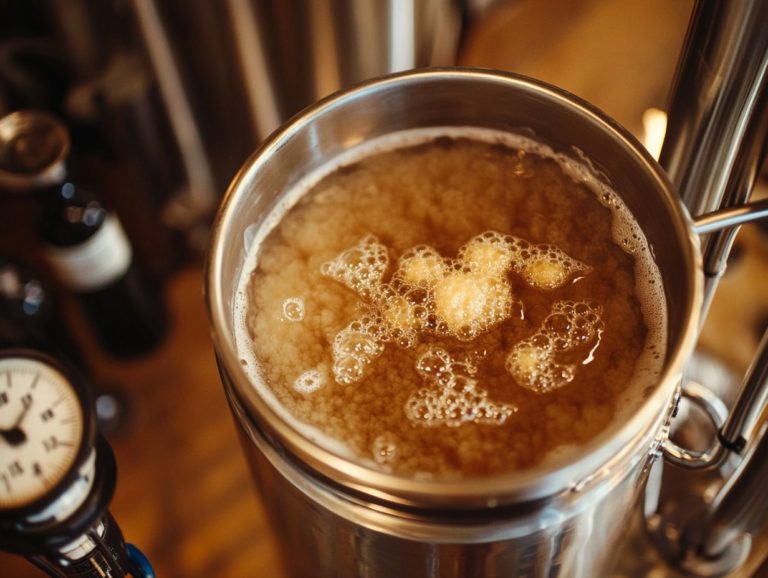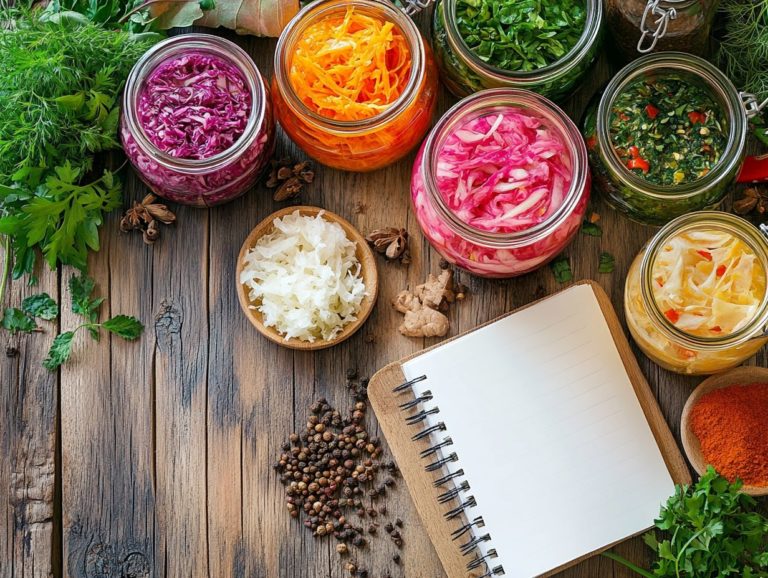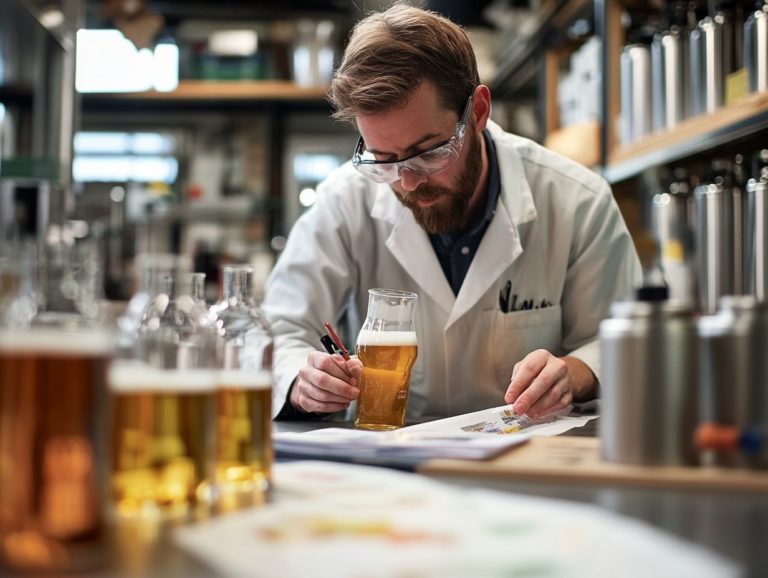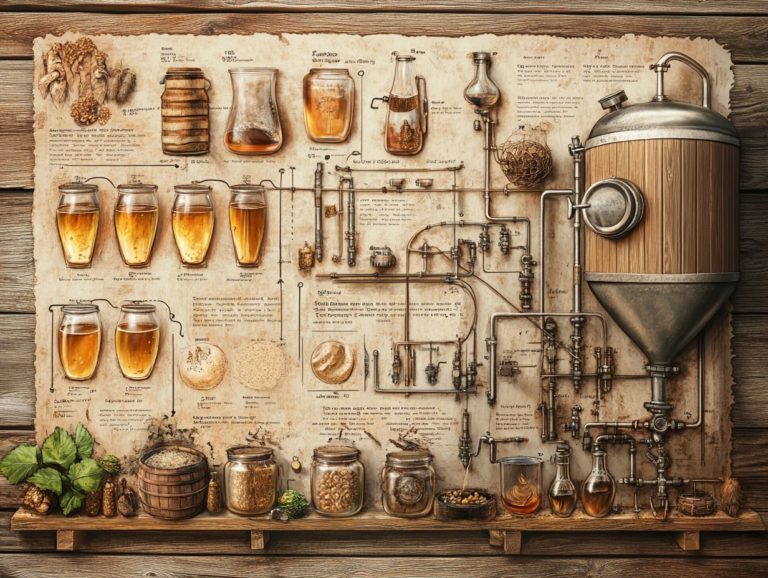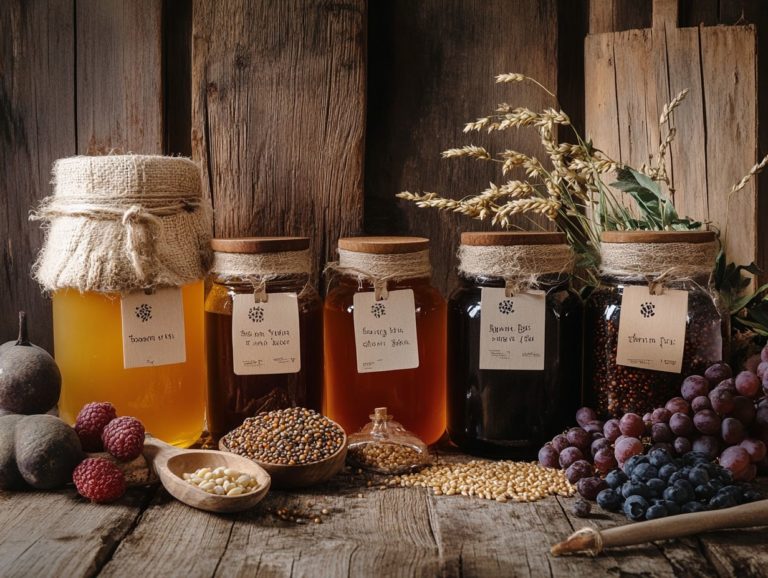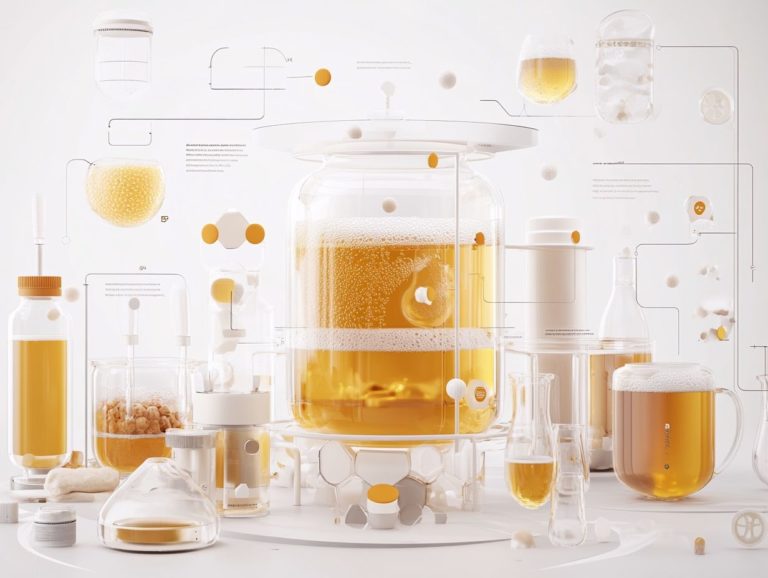What Happens During Malolactic Fermentation?
Malolactic fermentation (MLF), a process where sharp malic acid is converted into softer lactic acid, is vital in winemaking. This fascinating process transforms the sharp malic acid present in grapes into gentler lactic acid, enriching the overall character of the wine and contributing to its stability.
This secondary fermentation is very important for winemakers, as it directly influences the wine’s flavor profile, mouthfeel, and overall texture, while also enhancing its stability and microbial control.
Get ready to explore the steps involved in malolactic fermentation, uncover the factors that influence it, such as fermentation temperature and pH level, and weigh its benefits and potential risks, including faults and sensory changes.
Explore how this essential process plays a pivotal role in shaping the wines you cherish, from beloved Chardonnay and red wines to Riesling and Gewurztraminer.
Contents
- Key Takeaways:
- What Is Malolactic Fermentation in Wine Production?
- Why Is Malolactic Fermentation Important in Winemaking?
- What Are the Steps of Malolactic Fermentation?
- What Factors Affect Malolactic Fermentation?
- What Are the Benefits of Malolactic Fermentation?
- 2. Enhanced Flavor and Aroma
- 3. Increased Stability
- What Are the Risks of Malolactic Fermentation?
- 1. Spoilage by Harmful Bacteria
- How Can Malolactic Fermentation Be Controlled?
- Use of Starter Cultures
- Monitoring and Adjusting Temperature and pH
- 3. Adding Nutrients for Optimal Wine Production
- Frequently Asked Questions
- What Happens During Malolactic Fermentation?
- Why Does Malolactic Fermentation Occur?
- How Is Malolactic Fermentation Different from Primary Fermentation?
- What Are the Benefits of Malolactic Fermentation?
- Are All Wines Subjected to Malolactic Fermentation?
- How Long Does Malolactic Fermentation Take?
Key Takeaways:
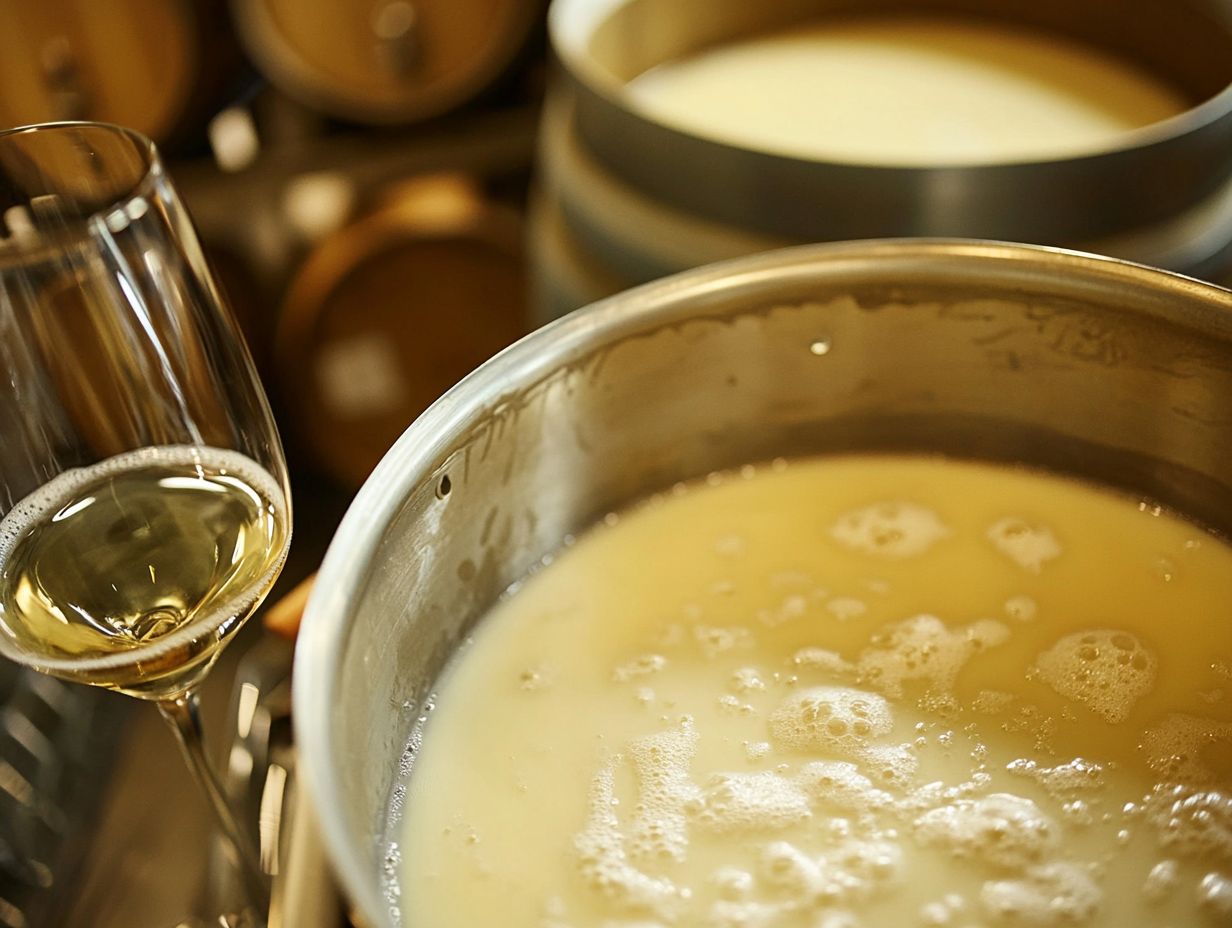
- Malolactic fermentation is a natural process in winemaking that converts sharp malic acid into softer lactic acid, improving the overall taste, aromas, and mouthfeel of the wine. It also contributes to clarity and aging.
- Factors such as temperature, pH level, and sulfur dioxide levels can affect the success of malolactic fermentation and must be carefully controlled.
- MLF can be beneficial for wine, but it also carries risks such as spoilage and off-flavors. Proper monitoring and control techniques, such as the use of starter cultures, nutrients, and malolactic cultures, can help ensure a successful fermentation process.
What Is Malolactic Fermentation in Wine Production?
Malolactic fermentation (MLF) is a vital secondary fermentation process in the world of wine production. During this intriguing transformation, the tart malic acid naturally present in grape must is converted into the softer lactic acid by lactic acid bacteria, particularly Oenococcus oeni, and other lactic bacteria such as Lactobacillus and Pediococcus.
This shift not only softens the wine s acidity, enhancing its mouthfeel and texture, but it also adds layers of complexity to its aromas and flavors. You might notice a delightful buttery flavor profile and fruity floral notes emerging that wine enthusiasts often love.
MLF also plays a significant role in the microbiological stability of wines, influencing their overall quality and aging potential. Each sip is a testament to craftsmanship and time, much like the contributions of pioneers such as Louis Pasteur, Hermann M ller, Jean Rib reau-Gayon, and mile Peynaud.
Why Is Malolactic Fermentation Important in Winemaking?
Malolactic fermentation (MLF) plays a crucial role in winemaking, elevating both the stability and flavor complexity of the wine, and transforming your sensory experience of the final product.
By converting the sharp acidity of malic acid into the gentler lactic acid, MLF creates a more rounded mouthfeel and extends the finish on the palate. This process helps prevent potential faults through effective prevention techniques and enhances the overall balance of the wine, making it more enticing to consumers, particularly in beloved varietals like Chardonnay, Cabernet Sauvignon, and red wines.
What Are the Steps of Malolactic Fermentation?
The process of malolactic fermentation (MLF) encompasses several pivotal steps that transition your wine from a sharp, acidic profile to a smoother and more intricate mouthfeel, which is vital for producing high-quality wine.
Initially, you need the presence of lactic acid bacteria, especially Oenococcus oeni, to kickstart the transformation of malic acid abundant in grape must into lactic acid. Once this conversion takes place, the fermentation process produces carbon dioxide, acetoin, and heat, which are essential byproducts that contribute to the wine’s maturation.
This phase significantly influences the wine’s final characteristics and sensory attributes, elevating your winemaking journey to new heights.
In conclusion, malolactic fermentation is a crucial process in winemaking that enhances flavor complexity, stability, and the overall quality of the wine, ensuring a delightful experience for consumers.
1. Conversion of Malic Acid to Lactic Acid
Impact on Wine Sensory Evaluation
The conversion of malic acid to lactic acid serves as the cornerstone of malolactic fermentation, where lactic acid bacteria like Oenococcus oeni play a crucial role in transforming the sharp acidity of the wine into a smoother and more enjoyable experience.
This chemical process not only reduces acidity but also enriches the wine’s complexity, resulting in a more refined taste, mouthfeel, and flavor persistence.
During this fermentation, Oenococcus oeni employs malic acid as a substrate in its metabolic pathway, skillfully converting it through decarboxylation into lactic acid while releasing carbon dioxide. This amazing transformation softens the wine’s acidity and introduces subtle flavors and aromas, such as diacetyl and ethyl lactate, imparting a creamy or buttery quality that many wine aficionados cherish.
Other lactic acid bacteria may also contribute to this delicate dance, further refining the flavor profile and enhancing the wine’s stability. The interplay of microbial activity profoundly influences the wine’s texture and balance, enabling winemakers to craft distinct characteristics that truly resonate with consumers. This is the essence of wine microbiology and sensory perception in the winemaking process.
2. Production of Carbon Dioxide and Heat during Malolactic Fermentation
During malolactic fermentation, the production of carbon dioxide and heat is a natural byproduct that plays a crucial role in shaping the fermentation process and the overall characteristics of the wine. This effervescence not only aids in stabilizing the wine but also adds to the complex vinous aromas and flavors that set high-quality wines apart.
The dynamics of carbon dioxide release create an anaerobic environment, essential for certain bacteria involved in this secondary fermentation. The heat generated during this process can elevate the temperature of the fermentation medium, influencing the metabolic rates of both yeasts and bacteria.
If left unchecked, higher temperatures can result in unwanted byproducts, such as volatile acidity, which is a measure of the wine’s acidity that can result in an unpleasant vinegar-like flavor if too high. On the flip side, maintaining the right thermal conditions can enhance the development of desirable sensory attributes, promoting softer textures and a smoother mouthfeel.
By grasping these interactions, winemakers can create wines with well-defined profiles, achieving a balance between acidity and flavor complexity while ensuring a consistent fermentation environment.
What Factors Affect Malolactic Fermentation?
Several factors can profoundly influence the efficiency and outcome of malolactic fermentation, such as fermentation temperature, pH level, and the presence of sulfur dioxide. Each of these variables is crucial in managing the microbial behavior of lactic acid bacteria, significantly impacting both the fermentation process and the sensory attributes of the wine.
Effective winemaking techniques can optimize these conditions, producing superior grape varieties and ensuring wine clarity. By understanding these elements, winemakers can create optimal conditions for a successful malolactic fermentation, ensuring that the final product achieves the desired flavor profiles and stability.
1. Temperature
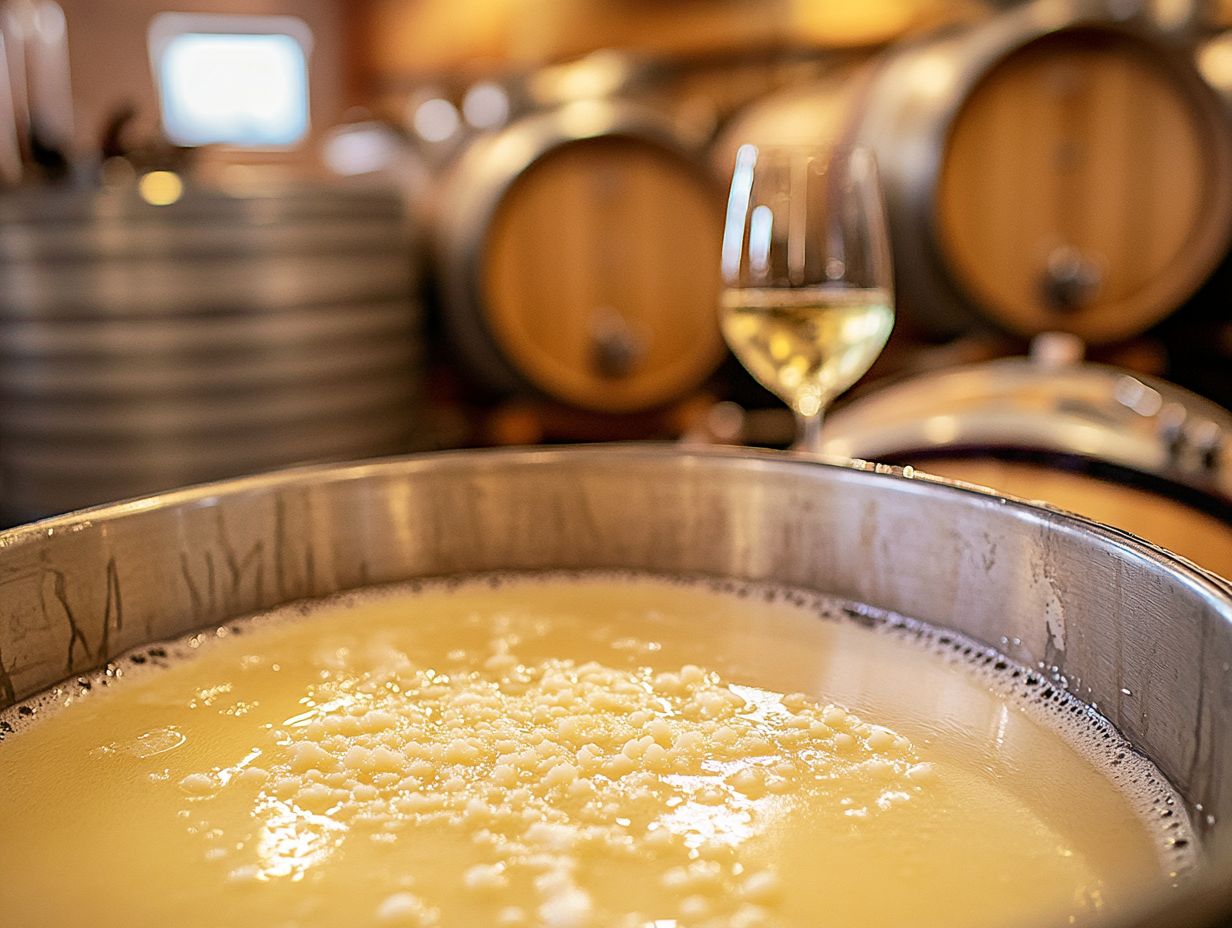
Fermentation temperature is critical in malolactic fermentation. It directly impacts how effectively lactic acid bacteria convert malic acid into lactic acid. Aim for temperatures between 18 C and 22 C, where these bacteria thrive. Straying from this range can hinder their function, leading to incomplete fermentation and affecting the pH increase.
As a winemaker, it’s crucial to closely monitor these temperature ranges to craft the desired texture and flavor profile in your final wine. If temperatures dip below 18 C, you risk slowing down the lactic acid bacteria, which could delay fermentation or possibly bring it to a standstill. On the flip side, if temperatures exceed 22 C, the bacteria may become stressed, resulting in off-flavors or unwanted volatile acidity.
Implementing effective temperature management techniques, such as controlled heating and cooling systems, is essential for maintaining these optimal conditions. By diligently monitoring temperature fluctuations during the fermentation process, winemakers can make timely adjustments to safeguard the quality and consistency of the wine being produced.
2. pH Level
The pH level of your wine significantly impacts malolactic fermentation. It directly influences the growth and activity of lactic acid bacteria.
A pH range of 3.2 to 3.5 is ideal for MLF, promoting optimal bacterial activity. If the pH strays too low or too high, you may disrupt fermentation and invite potential wine faults.
This balance is important because the right pH fosters the growth of these beneficial microorganisms and shapes the flavor profile and stability of your wine.
You can monitor pH levels throughout fermentation using pH meters or indicator strips. This allows for quick responses to any fluctuations.
If adjustments are needed, techniques such as acidification or dilution can fine-tune the pH levels. This ultimately enhances the quality of your final product.
Managing these parameters can greatly boost your chances of successful malolactic fermentation. This leads to a smoother and more complex wine with improved sensory perception.
3. Presence of Sulfur Dioxide
The presence of sulfur dioxide in wine poses a challenge during malolactic fermentation. It acts as both a preservative and a potential barrier to lactic acid bacteria.
Low levels of sulfur dioxide can effectively prevent spoilage and oxidation. However, high concentrations can stifle the activity of Oenococcus oeni and other essential lactic bacteria.
This balance is crucial for winemakers. You must manage sulfur dioxide levels carefully to ensure microbial control and develop the desired flavor profiles.
Monitor the fermentation process closely. Adjust sulfur dioxide additions based on your wine’s specific characteristics.
By timing your interventions and measuring throughout fermentation, you can encourage effective malolactic conversion while benefiting from sulfur dioxide s protective qualities.
This strategy allows you to craft well-rounded wines that excel in safety and flavor integrity.
What Are the Benefits of Malolactic Fermentation?
Malolactic fermentation (MLF) offers numerous advantages for winemakers. It enhances the overall quality of their creations.
By converting sharp malic acid into smoother lactic acid, MLF reduces perceived acidity. This process elevates the wine’s complexity, resulting in a more enjoyable experience for you as a consumer.
This fermentation process also improves the wine’s microbial stability, ensuring you receive a superior product capable of aging gracefully.
1. Improved Mouthfeel
One significant advantage of malolactic fermentation is the enhanced mouthfeel. It makes the wine smoother and more enjoyable.
As harsh malic acid transforms into softer lactic acid, the textural qualities shift. This creates a luxurious and rounded experience for you.
This transformation elevates the wine’s smoothness and changes how it interacts with your palate. You ll enjoy a delightful mix of acidity and creaminess.
Many enthusiasts favor wines with a plush mouthfeel, often associating it with superior quality. As evaluations increasingly emphasize tactile sensations, mouthfeel becomes crucial in shaping your preferences.
2. Enhanced Flavor and Aroma
Malolactic fermentation (MLF) plays a crucial role in enhancing the flavor and aroma profile of wines. It adds layers of complexity that enrich your sensory experience. This process can bring forth buttery notes and other appealing attributes, elevating the wine’s aromatic qualities and making it even more enticing.
As sharp malic acid transforms into softer lactic acid during MLF, it contributes to this complexity. This transformation imparts certain varietals with rich, creamy textures and delightful nuttiness. Take Chardonnay wines, for example; this popular white grape variety often showcases those buttery nuances, especially in oak-aged versions, where MLF harmonizes exquisitely with the toasty, vanilla notes from the barrel.
Even red wines like Merlot and Pinot Noir exhibit a more rounded mouthfeel and flavor profile, benefiting from the introduction of these softer, intricate flavors. Ultimately, the result is a wine that delights your palate and captivates your senses with its multifaceted character and flavor persistence.
3. Increased Stability
Increased stability is one of the standout benefits of malolactic fermentation. It gives you a wine that stands the test of time. Converting malic acid into lactic acid through MLF helps reduce spoilage risks, ensuring you re getting a more reliable product that enhances the wine’s aging potential.
This transformation is essential for microbial stability, as it lowers acidity and creates an environment that s less inviting for undesirable microorganisms. Through this acid reduction, your wine can maintain its character throughout the aging process, allowing complex flavors and aromas to flourish without interference from pesky bacterial activity.
When a wine undergoes malolactic fermentation, it showcases improved quality and becomes more resilient against common wine faults. Whether you’re a connoisseur or a casual drinker, you re guaranteed a more enjoyable experience. Your sensory perception of the wine will be enhanced, contributing to a higher level of consumer satisfaction.
What Are the Risks of Malolactic Fermentation?
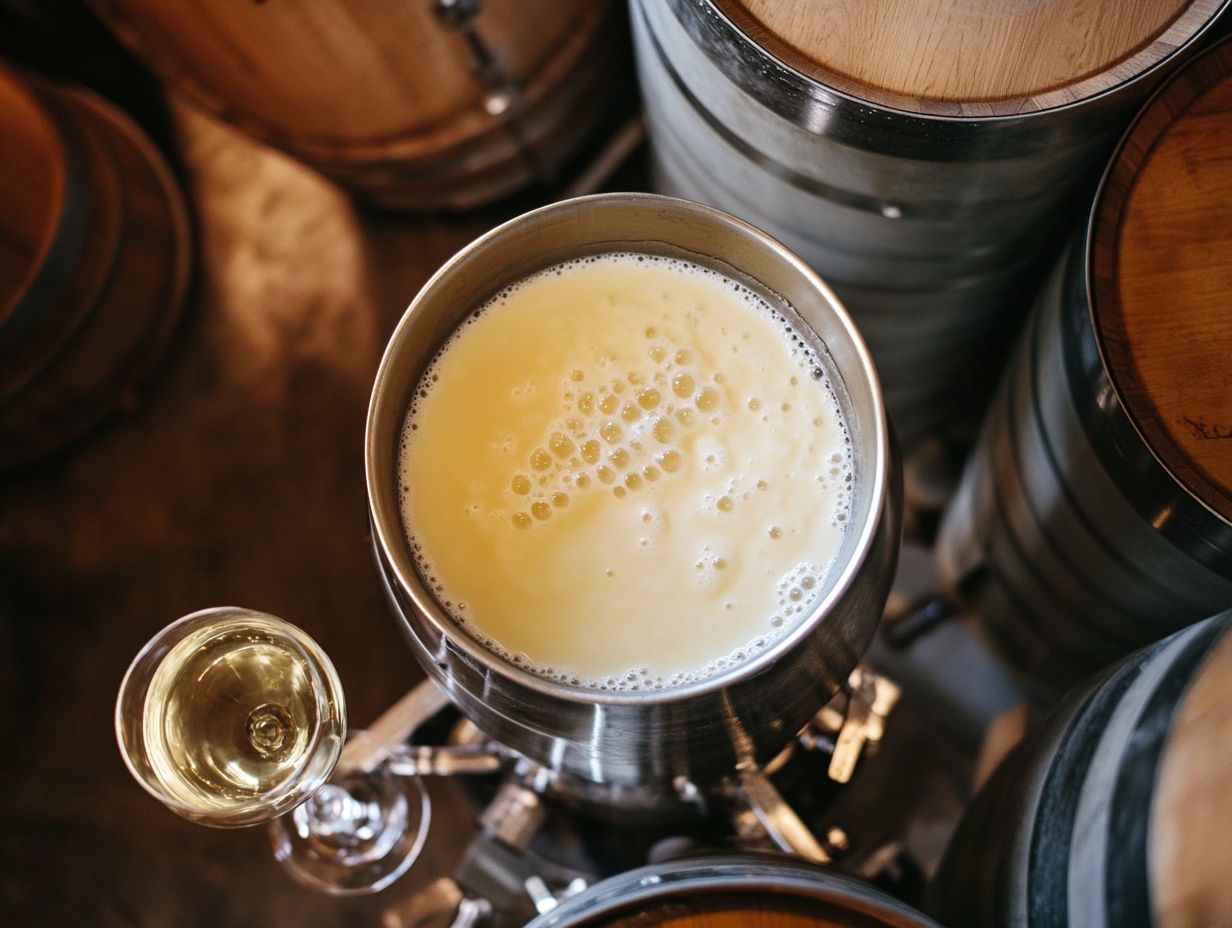
While malolactic fermentation offers numerous benefits, it also carries specific risks that must be carefully managed. These include the possibility of spoilage from harmful bacteria and the emergence of unpleasant off-flavors due to diacetyl production and other undesirable fermentative pathways.
If not controlled, MLF can lead to undesirable wine faults and acidity issues, jeopardizing the overall quality and allure of the wine. This, in turn, can lead to significant financial losses for producers.
1. Spoilage by Harmful Bacteria
Spoilage caused by harmful bacteria is a significant concern during malolactic fermentation. Unwanted microbial activity can introduce undesirable flavors and aromas to your wine. While Oenococcus oeni serves as the primary lactic acid bacterium essential for a successful MLF, be mindful that other strains can jeopardize the entire fermentation process, leading to spoilage.
Watch out for problematic bacteria like Lactobacillus and Pediococcus. These strains can produce off-flavors such as volatile acidity and diacetyl through acetoin production, undermining the wine’s intended profile.
To maintain the quality of your wine, it s crucial to implement stringent microbial control measures throughout the winemaking process. This might involve techniques such as keeping pH levels low to prevent increases, ensuring thorough sanitation of your equipment, and, in some cases, using sulfites to curb bacterial growth.
Effective microbial management is vital in preserving the desired characteristics of your wine, paving the way for a successful and enjoyable final product.
Off-Flavors and Aromas
During malolactic fermentation, you face the risk of developing off-flavors and undesirable aromas if the process isn t managed with precision. These off-flavors can detract from the overall quality of your wine, leading to faults that might negatively affect consumer satisfaction and sensory perception during wine sensory evaluation.
It’s crucial for you as a winemaker to remain vigilant. Problems like excessive volatile acidity or diacetyl may arise during this pivotal phase. Diacetyl, known for its buttery aroma, can be enjoyable in small doses but can easily overpower the wine if left unchecked.
If malolactic fermentation is incomplete or uneven, you could end up with a sour or unappealing taste that could disappoint your consumers.
To navigate these risks effectively, keep a close eye on temperature and pH levels, ensuring optimal conditions for the beneficial bacteria at work. Regular tasting and analysis during fermentation will enable you to identify and address potential issues before they manifest as faults that compromise your final product, thus contributing to wine faults prevention.
How Can Malolactic Fermentation Be Controlled?
Controlling malolactic fermentation is crucial for crafting high-quality wines. You have a range of sophisticated strategies at your disposal to ensure a successful fermentation process and optimal wine profiles.
By utilizing starter cultures of lactic acid bacteria, closely monitoring fermentation temperatures and pH levels, and thoughtfully adding essential nutrients, you can effectively manage MLF and elevate your winemaking to new heights, ensuring the desired sensory changes and complexity in your wine.
Use of Starter Cultures
The use of starter cultures is a prevalent practice in malolactic fermentation. It introduces specific strains of lactic acid bacteria, like Oenococcus oeni, into your wine. This not only promotes a controlled and predictable fermentation process but also helps outcompete potential spoilage organisms, increasing the chances of a successful MLF.
By utilizing starter cultures, you can streamline the fermentation timeline, achieving your desired flavor profiles with greater efficiency. These selected microbial strains dominate the fermentation environment, significantly reducing the risk of off-characters typically caused by wild bacteria.
Moreover, they contribute to a more stable acidity that enhances smoother taste and aroma qualities. Proper use of malolactic cultures can also reduce the likelihood of diacetyl production.
The consistency provided by starter cultures ensures that each batch of wine remains high in quality, meeting consumer expectations and boosting overall market appeal. This level of microbial control is crucial in defining the final character and complexity of your wine, ultimately leading to a more refined product that truly showcases the potential of the vineyard.
Monitoring and Adjusting Temperature and pH
Monitoring and adjusting temperature and pH levels during malolactic fermentation is essential for ensuring the successful activity of lactic acid bacteria and achieving optimal wine quality. By maintaining these ideal conditions, you can enhance the efficiency of malolactic fermentation (MLF) and significantly reduce the risk of spoilage.
Temperature is particularly critical; keeping it within the preferred range of 18-22 C allows lactic acid bacteria to thrive, which enhances the fermentation process and contributes to a smoother wine profile.
Maintaining pH levels around 3.2 to 3.5 is vital; any deviations could adversely impact microbial activity, resulting in undesirable flavors or even stalling the fermentation altogether. Understanding and managing these factors is essential for optimal wine microbiology.
To achieve the best results in wine production, you should regularly monitor these parameters with precise tools. Make adjustments as necessary through gentle heating methods or natural additives. This approach creates a favorable environment for beneficial bacteria like Oenococcus oeni to flourish, ultimately leading to a balanced and complex wine that is sure to delight your palate.
3. Adding Nutrients for Optimal Wine Production
By adding nutrients during malolactic fermentation, you can significantly boost the activity of lactic acid bacteria such as Lactobacillus and Pediococcus, ensuring a successful conversion of malic acid to lactic acid. This practice not only makes fermentation easier but also minimizes the risk of stuck fermentations or spoilage.
In particular, incorporating specific nutrients like amino acids, yeast extracts, and vitamins is crucial for energizing these beneficial microbes. These nutrients do more than just stimulate the growth of lactic acid bacteria; they contribute to the overall health of the fermentation environment as well, facilitating a smoother fermentation process and enhancing wine stability.
When you provide adequate nutritional support, you pave the way for a more complete fermentation and enhance the sensory characteristics of the final wine product. As a result, winemakers who meticulously focus on nutrient addition often find themselves rewarded with improved flavor complexity and stability, ultimately elevating the quality of their wines. This practice also helps prevent wine faults and improve wine clarity.
Frequently Asked Questions
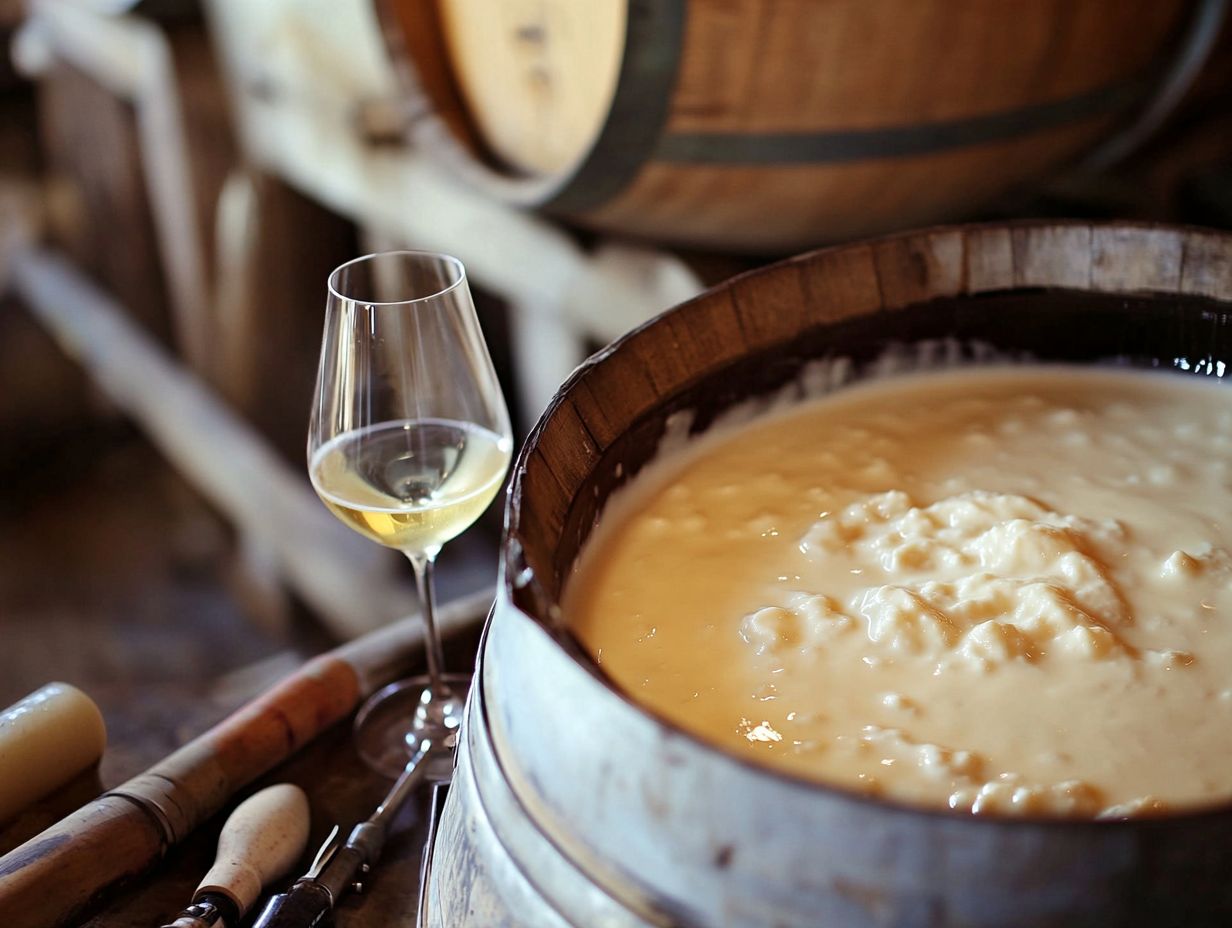
What Happens During Malolactic Fermentation?
Malolactic fermentation is a secondary fermentation process that occurs in some wines, where malic acid is converted into lactic acid. This process can significantly impact the characteristics and flavors of the wine, such as reducing tart malic acidity and enhancing flavor complexity.
Why Does Malolactic Fermentation Occur?
Malolactic fermentation is a natural process that can occur spontaneously in some wines. It is also sometimes intentionally induced by winemakers to improve the flavor and stability of the wine. This process is especially common in red wines and certain white wines like Chardonnay.
How Is Malolactic Fermentation Different from Primary Fermentation?
Primary fermentation is the process of converting grape sugars into alcohol, while malolactic fermentation is the conversion of malic acid into lactic acid. Primary fermentation is typically carried out by yeast, while malolactic fermentation is usually carried out by lactic bacteria like Oenococcus oeni.
What Are the Benefits of Malolactic Fermentation?
Malolactic fermentation adds a delightful softness and rounds out the acidity of wines, making them more palatable. It can also add complexity and depth to the flavor profile of the wine, often resulting in a smoother and more balanced taste. This is particularly evident in wines such as Chardonnay, where it can impart a buttery flavor due to the production of compounds like diacetyl, a compound that gives butter its flavor.
Are All Wines Subjected to Malolactic Fermentation?
No, not all wines undergo malolactic fermentation. This process is more common in red wines, particularly those with high levels of malic acid. Some white wines, such as Chardonnay, also commonly go through malolactic fermentation. Other wines like Riesling and Gewurztraminer may not undergo this process to preserve their fruity floral characteristics.
How Long Does Malolactic Fermentation Take?
The duration of malolactic fermentation can vary depending on factors such as the type of wine, the temperature, and the type of bacteria present. In general, it can take anywhere from a few weeks to several months to complete. Temperature control and the use of specific malolactic cultures can help manage this process effectively.
If you’re interested in learning more about winemaking or have any questions, feel free to explore further or reach out for more information!

